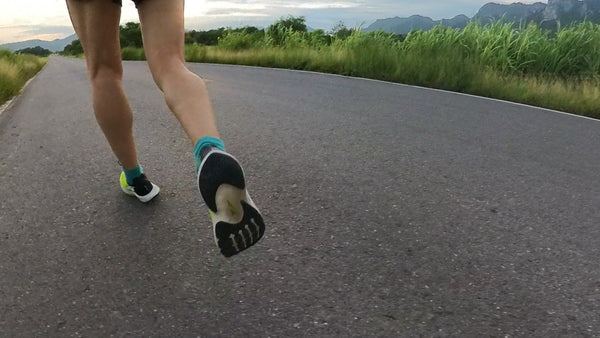Every step you take relies on a complex and fascinating system of biomechanics in your feet. From balance to shock absorption, every movement involves a literal balancing act to keep you walking, running, and standing in a pain-free, properly supported way.
However, when this balance is disrupted, it can lead to discomfort, pain, and even chronic conditions like fallen arches. One common disruptor of your body’s proper alignment and weight distribution through your feet is overpronation.
What is pronation and overpronation?

Pronation refers to the natural inward rolling movement of your foot as it strikes the ground during walking or running. This motion helps your body absorb shock efficiently, distribute weight evenly, and push off the ground properly as you move. Pronation is a normal part of a neutral stride, but there’s a fine line between normal and abnormal strides.
When this motion becomes excessive, it is referred to as overpronation. With overpronation, the arches of your feet collapse inward more than they should, causing your ankles to roll inward excessively. This misalignment can place added strain on your feet and other areas of your body, leading to discomfort and long-term problems if not addressed.
Causes of foot overpronation
Overpronation is often linked to specific factors, such as:
-
Genetics: Sometimes, the structure of your foot is inherited. Features like low arches or flat feet may be the result of your genetics.
-
Running or walking patterns: Certain walking or running habits, such as placing too much pressure on specific parts of the foot, can lead to overpronation over time.
-
Foot structure: Structural issues like weak tendons or ligaments in the feet can contribute to a tendency for overpronation.
-
Other musculoskeletal conditions: Conditions like arthritis or joint instability in your feet, ankles, knees, and hips can also increase the likelihood of overpronation by causing you to overcompensate during your gait due to pain, stiffness, or muscle imbalance.
Symptoms of pronation
One of the trickiest things about overpronation is that its symptoms can often go unnoticed for years, as many people mistake the discomfort as “normal” and don’t realize their walking pattern may be causing their chronic pain.
Although everyone is different and can have different symptoms, some of the most common symptoms of overpronators include:
-
Foot and ankle pain: Persistent discomfort in the arches, heels, or ankles may indicate overpronation.
-
Knee pain: Improperly aligned feet can increase stress on your knees, which in turn can lead to significant discomfort.
-
Hip pain: Overpronation can cause misalignment in your hips, leading to soreness or tenderness over time.
-
Lower back pain: Poor foot mechanics can even affect the lower back as the misalignment has a cascading effect up the body, leading to strain and pain in your lower back.
-
Flat feet: Visible flattening of your arches when standing is often a key indicator of overpronation.
How to correct overpronation
Addressing overpronation is crucial to preventing long-term pain, discomfort, and further injuries. The best way to correct and prevent overpronation is to provide your feet with the supportive foundation they need. In some cases, learning new movement mechanics and seeing a physical therapist can help solidify your results.
Custom orthotics for overpronation
While over-the-counter insoles and shoes may claim to offer the arch support you’re looking for, they often fall short of meeting the specific, varied needs of individuals with overpronation. Custom orthotics, however, offer several significant benefits that are always tailored to your unique foot structure.
Custom orthotics can provide the necessary:
-
Support: Orthotics provide proper arch support to correct the inward collapse associated with overpronation. This addresses the root issue and stabilizes your gait.
-
Alignment: Misalignment caused by overpronation can create a harmful ripple effect throughout your body. By helping to correct your foot and ankle mechanics, orthotics can improve the alignment of your entire body.
-
Shock absorption: Foot pain isn’t just caused by overpronation alone; the stress of each step can make your pain even worse. Our orthotics are cushioned and supportive, helping to absorb shock and reduce pressure on your feet.
-
Stability: By preventing excessive inward rolling of the foot, orthotics offer the stability necessary to walk and run confidently without risking further strain or injury.
Finally, one benefit of working with our lab in particular for your orthotics is that we customize the materials and support to match your lifestyle. So, if you’re an avid runner or athlete, your orthotics can be constructed with those activities in mind.
Custom orthotics to treat overpronation in any shoe
When it comes to correcting overpronation, one size doesn’t fit all. Biocorrect’s custom orthotics are uniquely crafted based on your specific biomechanics, current pain/symptoms, unique anatomy, and lifestyle. Whether you need support for athletic shoes, dress shoes, or everyday wear, our orthotics can be tailored to provide the support you need to live with less discomfort.
Get started with your custom orthotics today by scheduling an evaluation at our West Michigan orthotics lab or by requesting a virtual appointment if you live out-of-state. Virtual appointments for custom foot orthotics are easier than ever before with our new 3D Scan app that provides high-quality scans directly to our lab—no more waiting for a foam impression box in the mail!



